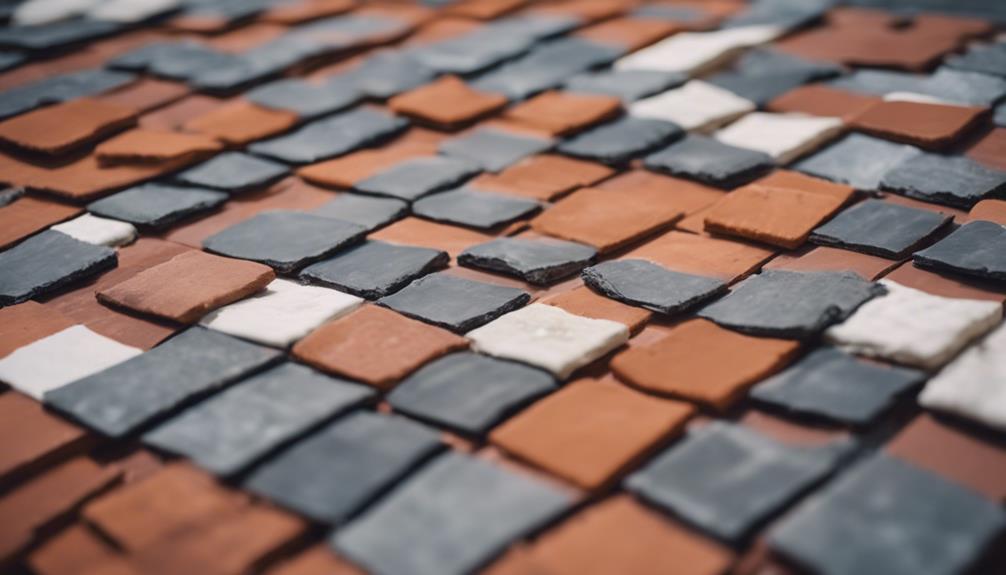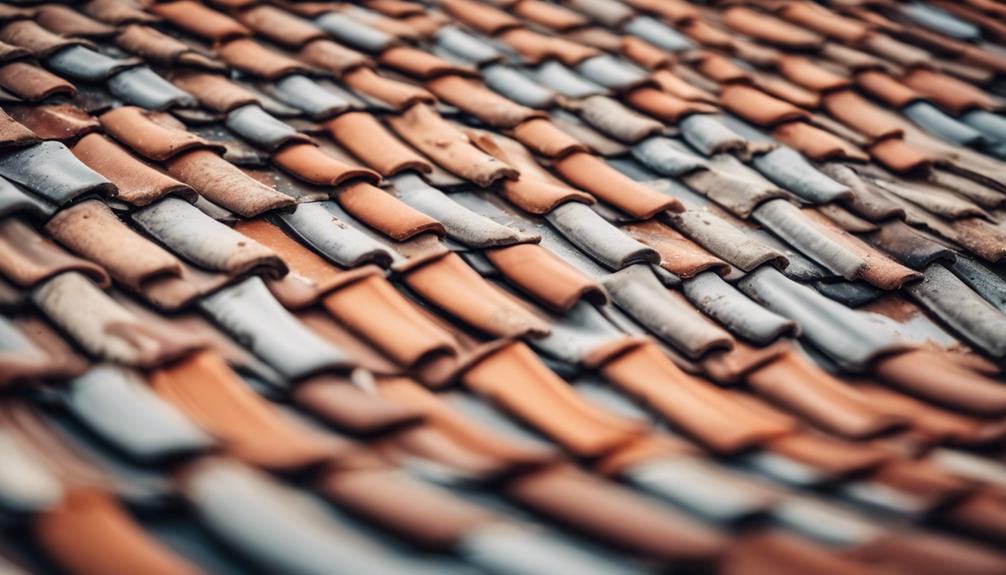What are the Cost Factors of Tile Roofing?
Tackle the intricate cost factors of tile roofing to unlock the secrets of a wise investment in your home's future.
When considering the installation of a tile roof, understanding the various cost factors involved is essential for making informed decisions.
From material expenses to installation costs, the financial aspects of this roofing option can greatly impact your overall budget.
By examining the breakdown of tile roofing costs and conducting a cost-benefit analysis, homeowners can gain valuable insights into the investment required for this durable and aesthetically-pleasing roofing solution.
Stay tuned to uncover key tips for maximizing the value of tile roofing and ensuring a cost-effective approach to enhancing your property.
What Is the Breakdown of Tile Roofing Costs?
When analyzing the breakdown of tile roofing costs, it is important to take into account various factors that contribute to the overall expense of installing and maintaining a tile roof.
The primary cost components include materials, labour, roof size, roof pitch, underlayment, and any additional features like insulation or protective coatings.
Materials play a significant role in determining the cost of a tile roof. The type of tiles chosen, such as clay, concrete, or slate, will impact the overall expense. Additionally, the quality and brand of the tiles will also affect the price.
Here’s a typical tile roofing installation cost in Surrey, UK:
| Roofing Material | Cost per Unit | Cost per Square Meter |
|---|---|---|
| Concrete Tiles | £0.70 to £50 per tile | £50 to £70 per sqm |
| Clay Tiles | £0.40 to £20 per tile | £150 to £190 per sqm |
| Slate Tiles | £0.80 to £2.80 per tile | £200 to |
| Interlocking Tiles | £0.80 to £7 per tile | Varies |
| Replace the Entire Tiled Roof | varies | £10,000 to £20,000 |
Labour costs are another vital factor. Installing a tile roof requires skilled labour due to the complexity and weight of the materials involved. The more intricate the design or the steeper the roof pitch, the higher the labour costs are likely to be.
Roof size is a straightforward cost determinant, as larger roofs require more materials and labour. Roof pitches can also impact costs, as higher pitches may necessitate additional safety measures and expertise during installation. Finally, the underlayment, insulation, and special coatings for protection against elements add to the overall expenses of a tile roof.
What is the Cost-Benefit Analysis of Tile Roofing?
Considering the detailed breakdown of tile roofing costs, the next step involves evaluating the cost-benefit analysis of opting for a tile roof installation. Tile roofing offers various advantages that contribute to its cost-effectiveness over the long term. Here are some key points to take into account:
- Durability: Tile roofs are known for their longevity, often lasting 50 years or more with proper maintenance.
- Energy Efficiency: The thermal mass of tile helps regulate indoor temperatures, potentially reducing heating and cooling costs.
- Aesthetic Appeal: Tile roofs enhance curb appeal and can increase property value.
- Low Maintenance: Compared to other roofing materials, tile requires minimal upkeep, lowering ongoing expenses.
- Environmental Impact: Many tile options are eco-friendly and recyclable, aligning with sustainable building practices.
When weighing the initial investment against these long-term benefits, tile roofing emerges as a cost-effective choice for homeowners looking for a durable, energy-efficient, and visually appealing roofing solution.
What Factors Influence the Material Expenses for Tile Roofing?

Tile roofing material expenses play an important role in determining the overall cost of a tile roof installation. The cost of materials for tile roofing can vary greatly depending on the type of tiles chosen.
Clay tiles, known for their durability and aesthetic appeal, are typically more expensive than concrete tiles, which are a more cost-effective alternative. Additionally, the quality and brand of the tiles will also affect the overall material expenses.
In addition to the tiles themselves, other materials required for a tile roof installation include underlayment, battens, adhesives, fasteners, and flashing.
These materials are essential for ensuring the proper installation and longevity of the tile roof. The quality of these materials can impact the overall performance and durability of the roof.
When budgeting for a tile roof installation, it is essential to take into account not only the cost of the tiles but also the additional materials needed for a successful installation.
How Do Installation Costs Influence the Choice of Tile Roofing?
The installation costs associated with tile roofing encompass labour expenses and specialized equipment required for the meticulous placement of the tiles onto the roof structure.
Installing tile roofing involves a series of precise steps that demand skilled labour and specific tools to guarantee a durable and aesthetically pleasing finish. Some key factors influencing the installation costs for tile roofing include:
- Labour costs for skilled roofers proficient in tile installation techniques.
- Cost of specialized equipment such as tile cutters, saws, and hoisting machinery.
- The complexity of the roof design can impact installation time and labour requirements.
- Transportation costs for delivering heavy and fragile tile materials to the site.
- Waste disposal expenses for old roofing materials or damaged tiles during the installation process.
Efficient coordination between labour, equipment, and material delivery is essential to streamline the installation process and minimize costs while maintaining the quality and longevity of the tile roof.
How Can I Maximize the Value of My Tile Roofing?

To enhance the longevity and value of a tile roof, it is imperative to implement strategic maintenance practices that optimize its performance and aesthetic appeal. Regular inspections should be conducted to identify and address any issues promptly.
Clearing debris such as leaves, branches, and moss helps prevent water pooling, which can lead to damage. Repairing or replacing broken or damaged tiles promptly is vital to prevent water infiltration and structural issues.
It is also essential to make sure that the roof’s underlayment is in good condition to provide an extra layer of protection.
In addition to maintenance, enhancing the curb appeal of a tile roof can increase its overall value. Consider pressure washing the tiles to remove dirt and grime, giving the roof a fresh and clean look.
Applying a protective coating can help prolong the lifespan of the tiles and enhance their colour. Consulting with roofing professionals for regular maintenance and guidance on maximizing the value of a tile roof is recommended.
Frequently Asked Questions
What Are the Most Common Types of Tile Materials Used for Roofing and How Do They Differ in Cost?
The most common types of tile materials used for roofing are clay, concrete, and slate. Each material offers unique aesthetics, durability, and weight characteristics. Clay tiles are typically more expensive than concrete, while slate tends to be the most costly due to its premium quality.
Are There Any Additional Costs or Considerations When Installing a Tile Roof on a Complex or Multi-Level Structure?
When installing a tile roof on a complex or multi-level structure, additional costs may arise due to increased labour for accessing and working on various levels, potential structural modifications, and specialized equipment requirements.
How Do Maintenance and Repair Costs for Tile Roofing?
Maintenance and repair costs for tile roofing vary based on factors like material quality, installation, and climate. Tile roofs generally have higher initial costs but can be more durable long-term, potentially requiring less frequent repairs compared to other roofing materials.
Are There Any Hidden Costs or Potential Pitfalls to Be Aware of When Budgeting for a Tile Roofing Project?
When budgeting for a tile roofing project, it is important to take into account potential hidden costs such as underlayment replacement, structural reinforcement, and specialized labour. Proper planning and thorough inspection can mitigate these pitfalls.
Can Homeowners Expect to See a Return on Investment in Terms of Increased Property Value When Choosing Tile Roofing Over Other Options?
Homeowners can expect a considerable return on investment with tile roofing due to its durability, energy efficiency, and aesthetic appeal. Resale value typically increases, showcasing the long-term benefits of choosing this roofing option.